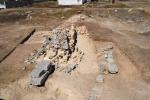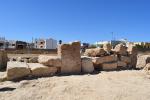Summary (English)
This was the second season of excavations in the locality of Palombara, an area situated in the eastern sector of the Messapian settlement of Muro Leccese.
The area excavated last year was cleaned and then extended to the north-east by opening a 15 × 10 m strip (fig. 1).The removal of a wall of irregular stones, interpreted until the early 1900s as the inner curtain wall, and inside which several fragments of medieval and post-medieval pottery were found, revealed a series of rooms, 4 to date, with walls that, at one point, are preserved to just under one metre (fig. 2).
Room 100 was the largest, divided by a wall built of reused blocks, including a column drum c. 60 cm in diameter and numerous orthostats of notable size (fig. 3). The abandonment layer in this room covering the floor contained numerous cooking pot, pithoi, and amphora fragments. Last year, an infant burial underneath an imbrex was found in the north-east corner of the room, and this season a small stone altar resting on two small pillars was found in the north-west corner.Two smaller rooms were found west of room 100, 101 to the north and 102 to the south. To the north of room 100 lay room 103 whose northern perimeter wall remains to be identified.
In all rooms, the crushed tufa floors showed substantial traces of exposure to fire and blackening. The discovery, together with these traces, of the carbonised remains of a wooden hinge from the door to room 100 suggests the structure was destroyed in a violent episode.
East of room 100, the situation was far more complex. The removal of the surface layers exposed a substantial collapse of small to medium stones in which large stone blocks were also present (fig. 4).The materials found during the excavations and sondages opened in rooms 100 and 101, suggest that the structure was built in the late archaic period: a hoard of silver incuse coins now on display in the Borgo Terra Museum, a terracotta slab with plaited motifs, a fragment of a cup-skyphos probably of colonial production, fragments of an Attic cup-skyphos from the workshop of the Haimon painter and an Attic lamp confirm the proposed chronology. The building probably remained in use until the early 3rd century B.C.
- Francesco Meo - Università del Salento
Director
Team
- Laura Masiello- Soprintendenza Archeologia Belle Arti e Paesaggio per le Province di Brindisi, Lecce e Taranto
- Catia Bianco- Università del Salento
- Teresa Oda Calvaruso
Research Body
- Dipartimento di Beni Culturali - Università del Salento
Funding Body
- Comune di Muro Leccese






![Download [PDF]](/excavation/skins/fasti/images/results/download_sml.png)


